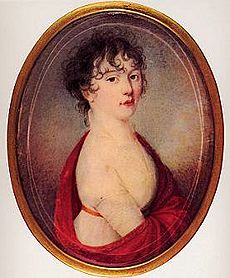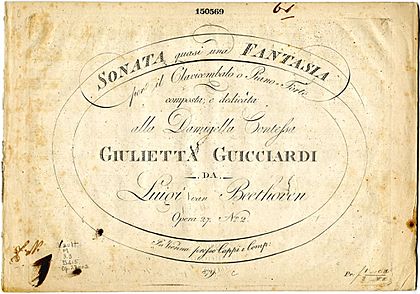Julie Guicciardi facts for kids
Julie "Giulietta" Guicciardi (born November 23, 1784; died March 22, 1856) was an Austrian countess. For a short time, she was a piano student of the famous composer Ludwig van Beethoven. He dedicated his Piano Sonata No. 14 to her. This piece later became very famous as the Moonlight Sonata.
Contents
Her Life Story
Julie Guicciardi was born in Przemyśl, which was then part of Austrian Poland. Her parents were Count Franz Joseph Guicciardi and Countess Susanna von Brunswik.
In June 1800, Julie moved to Vienna with her family from Trieste. She was known for her beauty and quickly became noticed by important people in society. On November 14, 1803, she married Count von Gallenberg, who was a composer. After their marriage, they moved to Naples. Julie returned to Vienna in 1822. She passed away in Vienna in 1856.
Her Link to Beethoven
Beethoven met Julie Guicciardi through her cousins, the Brunsvik family. He was very close to her cousins, the sisters Therese and Josephine Brunsvik. He had been teaching them piano since 1799.
Beethoven's Teacher Role
In late 1801, Beethoven started teaching piano to Julie Guicciardi. It seems he developed strong feelings for her. On November 16, 1801, he wrote to his friend Franz Gerhard Wegeler about an "enchanting girl." He said she made his life much more pleasant. He felt happy again after a sad two years. He also mentioned that he felt marriage could make him happy, but she was not from the same social class as him.
The Moonlight Sonata
In 1802, Beethoven dedicated his Piano Sonata No. 14 to Julie. He used the Italian form of her name, "Giulietta Guicciardi," for the dedication. The sonata was originally called Sonata quasi una Fantasia, which means "Sonata like a Fantasy." Later, it became widely known as the Moonlight Sonata.
This dedication was not Beethoven's first idea. He did not write the Moonlight Sonata with Julie in mind. According to Thayer, a historian, Beethoven first planned to dedicate another piece, the Rondo in G, Op. 51 No. 2, to Julie. However, that piece had to be dedicated to Countess Lichnowsky instead. So, at the last minute, Beethoven chose the Moonlight Sonata to dedicate to Julie Guicciardi.
The "Immortal Beloved" Mystery
In 1823, Beethoven told his secretary and biographer Anton Schindler that he had indeed been in love with Julie at that time. In his 1840 biography of Beethoven, Schindler claimed that Julie was the person Beethoven wrote to in his famous "Immortal Beloved" letter.
However, Julie's cousin, Therese Brunsvik, questioned this idea. She knew about Beethoven's deep and long-lasting feelings for her sister Josephine. Therese believed the letters must have been meant for Josephine, not Julie. This mystery about who Beethoven's "Immortal Beloved" was continues to be debated by historians.
In the 1994 movie Immortal Beloved, Countess Guicciardi is played by the actress Valeria Golino.
See also
 In Spanish: Giulietta Guicciardi para niños
In Spanish: Giulietta Guicciardi para niños



